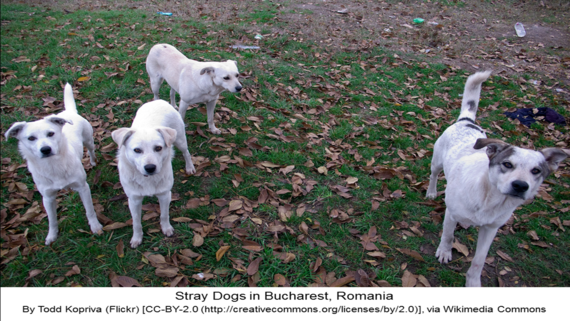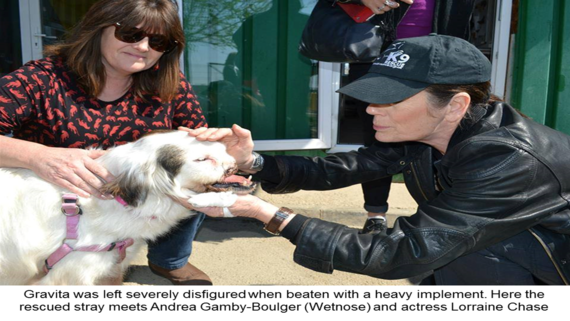With three million strays roaming its streets, and up to 65,000 freely roaming the capital, Romania has seriously gone to the dogs.
This unenviable status of "feral dog nation of Europe" has not happened overnight. It is a legacy of 1980s communism, when houses were replaced with high-rise flats with no-pet policies. It is the consequence of city expansion and rural-urban migration after the communist dictatorship fell in 1989. It is the product of poverty, and the lack of animal welfare infrastructure and strategies to cope with the ever-expanding stray dog populations. According to Occupy for Animals it is thought that over five million puppies are born every year in rural Romania.

Romania hit the international headlines in early September 2013, after a four-year-old boy was left unsupervised in a Bucharest park and mauled to death by stray dogs. A public backlash led to vigilante killings, and protests calling for government action. Images of dogs being beaten to death, and bloodied corpses lining pavements were shared across the world through social media.
Romanian Prime Minister Victor Ponta took drastic measures, announcing a law to legally euthanize any stray dog which has not been adopted from rescues after 14 days. Previously, only aggressive or incurable dogs could be legally killed. This decision divided opinion in Romania, and attracted global outrage.
Rudd Tombrock, the European Director of World Society for the Protection of Animals (WSPA), stated: "The mass culling of dogs lacks compassion and defies the values and respect for life we would normally expect from EU members. The European community has the task of protecting those values, and WSPA will rally all parties to act according and call for accountability of those who do not."
Despite a challenge in the Constitutional Court, the Romanian lawmakers ruled in favour of this method of control on 25 September. Prime Minister Ponta told Reuters: "You cannot postpone a decision between a kid's life and a dog's life. It is very clear that the decision should be to protect people's life." Public safety was positioned over animal welfare to legitimize a nationwide cull.
For many, the mere idea of putting healthy dogs to sleep is wrong; yet it still takes place in the UK. In September 2013, The Dogs Trust* reported that nearly 112,000 stray dogs had been collected by Local Authorities this year, with nearly 9,000 being put to sleep. Local authorities and charities generally cite lack of space and funds for such deaths. (*Please Note: The Dogs Trust does not euthanize healthy dogs)
The Romanian situation, however, is very different. The scale and extremity of the issue is enormous. Many of the stray dogs are feral, having been born in the wild. Few have gone missing, but rather abandoned, and left to fend for themselves. Many consider these animals to be pests, not pets. But should this make a difference to their treatment? They are, of course, still dogs with a history of human companionship in Europe.

Unlike the UK, euthanasia methods are also inhumane. According to Wetnose Animal Aid, Romanian media reports state this includes 'beating to death, clubbing, injecting paint thinner or other cheap toxin into the lungs, burning, drowning and poisoning with substances including antifreeze'. EU law would not sanction such methods of killing.
On March 5 2014, Dr Rita Pal of the Huffington Post, reported: 'Neglect of Stray Dogs - MEPs Deliver Damning Indictment of Romania's Mismanagement'. This external political pressure is, of course, positive; but just that. Within EU law individual member states are responsible for animal welfare, such affairs are managed internally. ASPA, the Romanian government agency responsible for collecting dogs, deny any wrongdoing. ASPA coordinator, Rachid Baba, is even quoted as saying "the capturing methods are not the most elegant, but they're according to the law".
If EU law, international pressure and condemnation on social and printed media have not influenced change so far, is there any hope for the future welfare of Romanian stray dogs? What else can be done? Alongside continued pressure and insisting the issue remains in the public eye, international collaboration with those who can facilitate humane management may well be the answer.
Wetnose Animal Aid recently teamed up with British and Romanian based dog rescuers (Norton Animal Rescue Foundation and K-9 Angels), media personalities (actress Lorraine Chase and Saffron from the band Republica) and a camera crew (SWL.TV) to document the stray dog situation in Romania. Founders Andrea and Gavin Gamby-Boulger explained: "The purpose of the mission was to try and find out an up to date overview of the stray dog situation mainly in Bucharest, as we felt it would be an indicator of the whole of Romania."
This mercy mission documentary, which has already gained celebrity support from Amanda Holden, Paul O'Grady, Matthew Wright and Richie Kul, will see the team visiting Maoland Shelter, Red Panda Shelter, Sparanta Shelter, and Iona Place, and gaining eye-witness accounts from experts and officials. "We did have a few tears there and when we got back home", explained Andrea Gamby-Boulger. "If the authorities had a Neuter and Release programme, we wouldn't be in this situation. We want to help direct donations to the humane shelters and promote these centres. We hope the documentary will help raise awareness in Romania, UK and beyond".
Sterilization presents itself as the most sensible and humane alternative for the stray dogs of Romania. Animal rights group Occupy for Animals (2013) agree with this sentiment, stating: "As long as the dogs with owners will not be sterilized, through coherent programs, Romania's streets will never be free of dogs... The only proven and humane method of stray animal's population control is the sterilization and return of the gentle and healthy stray dogs, compulsorily accompanied by the sterilization of dogs with owners that are the main source of street dogs by mass abandoning".
Expectations of a Romanian cultural shift on this issue are unrealistic. Dog owning habits, funding of facilities, management of programs, attitudes towards dog abandonment and public perceptions of strays need to change. All of this is reliant on the Romanian population. Should the world just stand by as this happens? No. Romanian individuals and organisations do offer humane alternatives. It is these facilities, these programs, which will benefit from external collaboration and support, and "potentially" become welfare beacons which influence justice for Romanian stray dogs.
(If you would like to reproduce this article please contact the author. Dr Daniel Allen is also available for commission - exploring people's interactions and understandings of animals from around the world)
